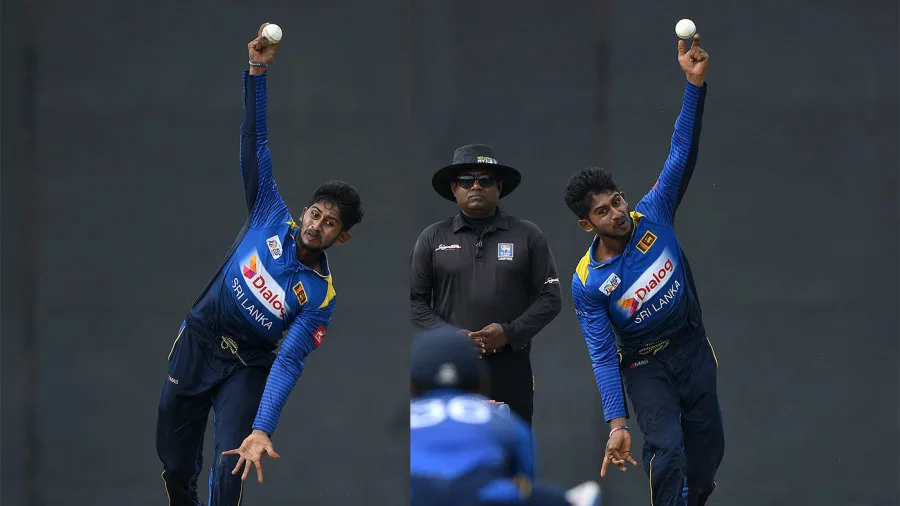Despite flashes of promise, true ambidextrous spin talents like Sri Lanka’s Kamindu Mendis and Tharindu Ratnayake remain a rarity in Bangladesh.
Around the cricketing world, unorthodox bowling actions are not uncommon. But few countries can match Sri Lanka’s wealth of unconventional bowlers—ranging from the legendary Muttiah Muralitharan to slingy pacers like Lasith Malinga and, more recently, Matheesha Pathirana and Nuwan Thushara. Among their latest innovations are ambidextrous spinners Kamindu Mendis and Tharindu Ratnayake—both capable of bowling with either arm.
While ambidextrous bowling remains rare, Sri Lanka’s Hassan Tillakaratne first made headlines in the 1996 World Cup, bowling with both arms during the final over against Kenya. For years, such feats were considered novelty. Now, they are a growing part of the Sri Lankan cricketing fabric.
But where are the Bangladeshi equivalents?
A closer look reveals a handful of names: Rayan Rafsan Rahman, Husne Habib Mehedi, and former women’s national team cricketer Shailla Sharmin. However, none have made a significant breakthrough into the top tiers of the sport.
Rafsan, a 27-year-old batting all-rounder, captained Shinepukur Cricket Club in the most recent Dhaka Premier League season. Though primarily an off-spinner, he can also bowl left-arm spin—a skill he began developing after watching Kamindu Mendis during the 2018 U19 World Cup. Under the guidance of his coach, former cricketer Jahangir Alam, Rafsan gradually learned to bowl effectively with both arms.
“My coach Jahangir Alam told me to keep going with it, that one day it would come naturally,” Rafsan recalled. “After two years of practice, it finally clicked.”
He first used his dual-arm bowling in a local Narayanganj league, gaining confidence against competitive opposition. “The local league matches are highly competitive, with players from the DPL and First Division. Facing them gave me the belief that I could do it.”
Despite these glimpses of potential, such bowlers have yet to feature prominently in Bangladesh’s senior teams. According to former Bangladesh selector and U-17 coach Hannan Sarkar, the lack of visible role models plays a major role.
“In Sri Lanka, after Malinga, we saw Pathirana and Thushara emerge. Now we see Kamindu and Tharindu,” Hannan told Times of Bangladesh. “In our context, such examples are missing. When children see someone in front of them doing it, they try to emulate it.”
He believes the rarity is due more to culture than capability. “It might start as a fun experiment in childhood, but without encouragement, it fades. These skills need to be nurtured from an early age.”
Former national cricketer and current HP Unit batting coach Rajin Saleh points to systemic issues—specifically, the discontinuation of spin and pace talent hunts.
“Previously, we had spin and pace talent hunts, but those have stopped. If we can revive them, we may discover unique talents who otherwise remain unnoticed,” said Rajin. “There are players who may not fully understand the technicalities of the game but possess raw talent. They just need a platform.”
Rafsan himself attributes the stagnation to Bangladesh’s cricketing culture, which he believes discourages deviation from the norm. “There’s a mindset here—everyone wants to stay within the basics. No one wants to go beyond the textbook,” he said. “We’re taught from a young age that there’s only one ‘correct’ way to bowl.”
Hannan’s observations echo that sentiment. “Our coaching system encourages players to become experts in one area. Coaches often advise players to focus on what they’re already good at, instead of exploring new dimensions,” he said. “Unconventional skills aren’t appreciated early on, so young players lose motivation.”
Rajin agrees that junior-level coaches often lack the willingness to accommodate unconventional styles. “Take, for example, a boy from Sylhet district who wants to try something different. If he’s not successful at first, he’s dropped, rather than encouraged. That’s demoralising.”
He believes the Bangladesh Cricket Board’s (BCB) Game Development wing should step in. “There are very few matches at the junior inter-district level. Teams play just two or three games. If the board ensures these unique bowlers get enough match time, we may see more breakthrough stories.”
Ultimately, both Rafsan and Mehedi remain fringe players. As Hannan points out, “Neither is an established name in domestic cricket. Rafsan is decent with the bat but isn’t a regular bowler. Mehedi also lacks consistent performances.”
Bangladesh’s journey towards nurturing ambidextrous bowlers is still in its infancy. For such talents to thrive, the system must evolve—embracing diversity in technique, celebrating uniqueness, and providing platforms where even the most unorthodox cricketer can dream of rising to the top.


